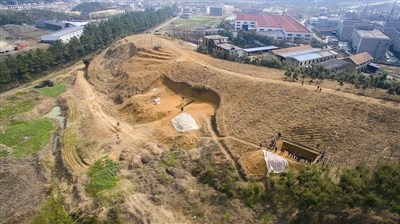
Aerial photo of the water project. (Photo/Hangzhou Daily)
Chinese archeologists said they have discovered a large water project dating back about 5,000 years in east China's Zhejiang Province.
The finding, which includes 11 dikes, is located on the outskirts of the provincial capital Hangzhou, and is the oldest large water system ever found in China. It is believed to have combined functions of flood control, transportation and irrigation.
The dikes are near to the ancient city of Liangzhu that existed about 4,500 to 5,300 years ago and was discovered in 2007 in Hangzhou's Yuhang District.
Between July 2015 and January 2016, archeologists excavated three of the 11 dikes, identifying pottery shards of the Liangzhu Culture, said lead researcher Wang Ningyuan with the provincial institute of cultural relics and archaeology. A "mound" excavated between 1996 and 2010 has now been identified it as a dike.
Carbon-dating tests on construction material -- straw and bamboo -- taken from the dikes showed dates of the site as between 4,700 and 5,100 years old.
High dikes erected along the mountains and low ones linking the mountains may have formed three reservoirs, one apparently covering 9.4 square kilometers -- about 1.5 times the area and four times the volume of Hangzhou's iconic West Lake.
Liu Jianguo with the Institute of Archaeology of the Chinese Academy of Social Sciences, who carried out geographic information system (GIS) studies, said high dikes were able to resist continuous rainfall of more than 800 millimeters and low ones 1,900 millimeters.
"Maybe our ancestors designed them to counter typhoons that brought torrential rain," he said.
A group of senior archeologists visited the dikes over the weekend. Professor Xu Shijin of Nanjing University speculated that one important purpose of the dikes was to water paddy fields, as poor yields at the time required large-scale planting.
"There were many craftsmen who made jade articles in Liangzhu 5,000 years ago, so they needed a large amount of grain," Xu said. The Liangzhu culture is well-known for exquisite jade.
Researchers said search should be continued to look for spillways and ditches and called for better protection of the site.
Professor Zhao Hui of Peking University said the discovery indicates that the settlement at Liangzhu was highly advanced.


















































